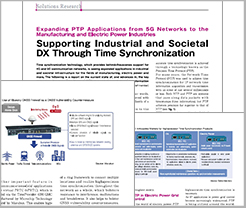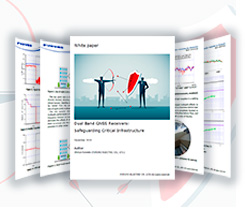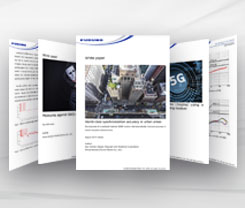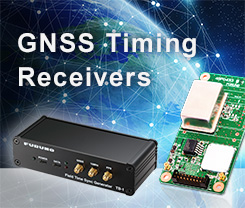Column
The Reason GPS Counts Time in 1.5-second Intervals
During Japan's Edo Period (1603–1868), people divided each day, as defined by the sunrise and sunset, into daytime and nighttime halves, and then divided each of these into six equal time blocks. Under this method, known as futei-jiho ("indefinite time" or "seasonal time system" in English), a single time subdivision block's length could vary by as much as 50 minutes between the winter and summer seasons. Clocks were not widespread at that time, so people instead synchronized time with their daily living cycles. In this article, we're going to explore another unique time-counting system—this one utilized by GPS.
GPS' Weak Point: The Week Number Rollover Phenomenon
Every navigation message sent by GNSS satellites contains all of the crucial information for positioning calculation. The time information is particularly essential among them.
In my previous articles, I introduced about the structuring of navigation messages using GPS (which was the first-ever GNSS) as an example. Despite the limited bit count, each of these messages can contain all of the information required, without any problem. However, this approach does have a certain weak point, which pops up every two decades or so. Specifically, this problem is known as "GPS Week Number Rollover"—something many readers may have heard of already.
GPS expresses time using only weeks and seconds, with the week count using a 10-bit number. Because just 10 bits are used, it's only possible to count weeks over a range from 0 to 1,023. Therefore, on August 22, 1999, which represented the 1,024th week from the cycle that began on January 6, 1986, GPS equipment reset to zero and caused problems for users everywhere. By the start of the 2,048th-week rollover on April 7, 2019, users had already experienced the phenomenon and thus applied what they learned to make improvements in receiver equipment. The result was fewer problems this time around—with the exception of some older equipment. Moreover, in the satellite systems that send the navigation messages, a new positioning signal was adopted, increasing the bit count for the week value. As a result, we won't have to worry about rollovers in the near future. The Week Number Rollover phenomenon is specific to GPS technology, which tightly packs information into a limited number of bits.
Initial Confusion Regarding the GPS 1.5-second Problem
The 10-bit week number is not the only concern with GPS. There is another related issue I have struggled with as a novice student in this field: the 1.5 second problem. This is something I have always been genuinely curious about — in the same way that one might ask why traffic signals are in the order red, yellow and green from top — and through research for my previous article, I feel that I have developed the knowledge necessary to accurately answer the question. Although this will require a rather deep dive into the subject, I'd like to explain my thought process, which was as follows.
1. GPS expresses time using only weeks and seconds. This is done using a 29-bit value called the "Z-count," whose most significant 10 bits are the Week Number (WN) count, and whose least significant 19 bits are the Time-Of-Week (TOW) count, which represents the number of seconds from the beginning of the week.
2. Explanations I had read stated that TOW is counted in 1.5-second intervals, which seemed odd to me.
3. A single week comprises 604,800 seconds, calculated as 7 days × 24 hours × 60 minutes × 60 seconds = 604,800. Therefore, when using binary numbering, a 20-bit value is surely needed (2^20 = 1,048,576).
4. If TOW is counted in 1.5-second intervals, however, the maximum value becomes 403,200 (calculated as 604,800 ÷ 1.5), for which a 19-bit number is sufficient (403,200 < 524,288, the latter being the result of 2^19). Counting in 1.5-second rather than 1-second intervals enables a 1-bit reduction.
5. A GPS navigation message, however, only assigns a 17-bit number for TOW, which is expressed in specification documentation as "TOW 17 bit truncated." Although it would normally require 19 bits to count up to 403,200, the truncated approach seems to do away with 2 bits entirely. How is this possible?
 A diagram showing the basic GPS navigation message structure (for an L1C/A signal), along with an expanded version of the TOW-related portion. Excerpt from the IS-GPS-200M Interface Specifications (source: https://gps.gov).
A diagram showing the basic GPS navigation message structure (for an L1C/A signal), along with an expanded version of the TOW-related portion. Excerpt from the IS-GPS-200M Interface Specifications (source: https://gps.gov).
The Results of Counting by Sixes and Fours
6. Time is the most important piece of information in positioning calculation, and it seems that these satellites' systems have been designed so that eliminating parts of numbers presents no problem. But how is this accomplished?
7. In my previous article, I explained how navigation messages are operated at 50 bits per second (bps), which is just as slow a data transmission rate as the old telex services. I also explained how and where the time stamp is recorded in the previous "subframe"—which is a collection of "words"— and the length which is 300 bits.
8. At a bit rate of 50 bps, the leading edge of a 300 bit subframe arrives every 6 seconds. Stated another way, all time stamps in GPS navigation messages are expressed in multiples of six.
9. TOW counts time in 1.5-second intervals, and this number is used as the divisor when expressing time in standard seconds. When 6 is divided by 1.5 (or divided by 3 then multiplied by 2), the result is a multiple of 4, meaning that TOW always uses a multiple of four.
10. The decimal-type number 4, when expressed as a binary, becomes 100 because multiples of 4 expressed in binary always contain "00" as their final two digits. As follows, the TOW value, which is always a multiple of 4, necessarily contains "00" as its final two digits.
11. Therefore, even if the final 2 bits of a TOW value—which one would expect to require 19 bits—are thrown out in order to make a 17 bit number, there is absolutely no loss of information.
 This diagram illustrates the relationship between a TOW count message and the Z-count. WN is assigned 10 bits and TOW is assigned 19 bits; however, only 17 bits are actually sent for TOW. The 604,800 seconds in one week's time become 100,800 when divided by 6, which can be communicated in 17 bits because 100,800 is less than 2^17 (= 131,072). Source: Geospatial Information Authority of Japan materials.
This diagram illustrates the relationship between a TOW count message and the Z-count. WN is assigned 10 bits and TOW is assigned 19 bits; however, only 17 bits are actually sent for TOW. The 604,800 seconds in one week's time become 100,800 when divided by 6, which can be communicated in 17 bits because 100,800 is less than 2^17 (= 131,072). Source: Geospatial Information Authority of Japan materials.
Just One of the Many Fascinating Secrets Found in a Complex and Massive System
As a somewhat over-the-top example, let's say you're staring at just one single tile from a grand cathedral. In that moment of realization, when you grasp that the design of this tile is not just a fragment, but contributing to the entire structure and meaning of the building it belongs to, you would undoubtedly experience a sense of awe and wonder. I felt the same way when I came to understand that discarding the final 2 bits when counting by 1.5 is the same as simply dividing by six. Because time is counted in 6-second increments by GPS, the above method enables sufficient communication of information without any loss. This is probably nothing out of the ordinary from the perspective of someone who works in binary on a regular basis.
In fact, when I shared this insight with a specialist, they responded with a mildly amused smile and said, "I see, so you've figured it out for yourself." This might have been a small "aha" moment for me as a beginner, but it also marked a significant point of personal growth.
At any rate, a baffling number of such complex trade-offs should have been utilized in order to realize the GPS frameworks we have today. Concepts such as Z-count and the TOW counting approach, which were born from limitations on information transmission quantities, are the a few of results of hard work and ingenious innovative thinking of our predecessors. It's likely there are more fascinating secrets to be found.
Writer introduction

Mr. Mitsunari Kita Science and technology writer
Born in Ishikawa Prefecture in 1964. Based on his experience in covering industrial technology, cutting-edge technology, and space development, he is passionate about unraveling and conveying difficult topics in an interesting way to people of all ages, from children to senior citizens. From 2009 to 2014, he was a member of the editorial board of "JAXA's," the official magazine of the Japan Aerospace Exploration Agency. Author and co-author of the following books: 『あなたにもミエル化? ~世間のなりたちを工学の視点から~』(幻冬舎mc)、『私たちの「はやぶさ」その時管制室で、彼らは何を思い、どう動いたか』(毎日新聞社)、『東京大学第二工学部70周年記念誌 工学の曙を支えた技術者達』(東京大学生産技術研究所) etc.,
* All registered trademarks used herein are the property of their respective owners.
Pick up
Column
FURUNO Column
-
Common Problems That Affect GPS/GNSS Time Synchronization

-
How to select GPS/GNSS antennas for time synchronization

Column by Mr. Mitsunari Kita (Science and technology writer)
-
The Observation Network Created by the Earthquake Proves Useful for Accurate Timekeeping (Part Two of Two) - A Solution to the "Mr. Higgins Problem" in Space -

-
The Observation Network Created by the Earthquake Proves Useful for Accurate Timekeeping (Part One of Two)

-
FURUNO ELECTRIC Joins Experts From Around the World on a Norwegian Island for Jammertest 2024

-
Unraveling the Mysteries of Venus Based on "Occultation"

-
Atoms as the Basis for Measuring Both Fleeting Moments and Near-Eternities

-
Time Progressing with a Speed Difference of Just 4.4647 Ten-Billionths!

-
Critters Who Revitalize Forests Through the Spreading of Food Caches

-
Small But Significant Variances in Gravity and Time (Part Two of Two)

-
Small But Significant Variances in Gravity and Time (Part One of Two)

-
Why the GT-100 Time-synchronization GNSS Receiver Module is Like Fragrant Soup Curry

-
What Rainbows Can Teach Us About Dual-Band GNSS

-
The Amazing Things That Are Possible With Just a Clock

-
When Subterranean Earth Meets Outer Space

-
Using the TB-1 and GT-100 at a "Multipath Dojo" in the Major Metropolis of Osaka

-
The Disaster-struck Field Time Sync Generator TB-1: True Performance Revealed Through a Lightning Strike

-
Knowing the "Now" of Our Earth Through GNSS

-
The Reason GPS Counts Time in 1.5-second Intervals

-
Similarities Between "On My Count!," the 117 Notification System, and GPS

-
Reliable Clocks Help Us Find a Silver of the Clouds

-
Why Time Synchronization is Vital for Criminal Investigations, Seismograph Measurements and Solar Wind Observation

-
What Was "Cesium" About Cesium Akina?

-
Updating Analog Broadcasting with GNSS Time Synchronization Technology

-
The Long History of One Second (Part II)

-
The Long History of One Second (Part I)

-
A Solo Journey - Three-liter Microsatellite Mission Support via GPS (GNSS) and Satellite Communication -

-
A Solo Journey - The GPS (GNSS) Tracking System That Helped Kenichi Horie Cross the Pacific -

-
The Day After a Superflare - Effects on power and wireless communication infrastructures -





